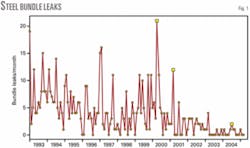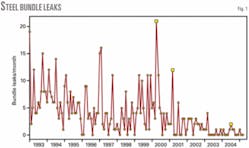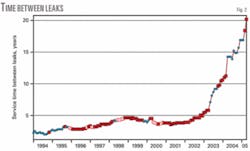Companies that use coatings to properly maintain and keep their heat-transfer equipment (HTE) clean can realize significant cost savings-in the form of reduced downtime and depreciation on capital equipment, improved energy efficiency, and stronger feed outputs.
Inefficient heat transfer in heat exchangers is a common bottleneck that plagues refineries and energy operations around the world, requiring considerable attention and, at times, and greater-than-anticipated expense.
In refineries, heat exchangers play a critical role in cooling and processing various streams. It is of paramount importance to preserve these systems to ensure they operate at maximum efficiency and prolong their working lives through good maintenance practices.
Because the cost of poorly performing HTE can cost well into the millions of dollars, many operators have usually found it preferable to maintain maximum operation efficiency and extend tube life by coating the inner diameters with phenolic materials.
Although the type of pipe metallurgy and tubular ID coatings can differ between oilfield, refinery, and pipeline applications, a preventive-coatings approach holds many advantages and can save millions in operational costs.
In the past, coating piping ID had to be done in special shops, not on site. That meant each heat exchanger had to be completely disassembled, shipped, and then reassembled; it precluded the largest units from being transported at all.
Progress in techniques has enabled in situ application to be common, and coatings are optimized to match the type of steel service conditions for best effect. Coatings can consist of bisphenol f, fluorinated products, phenolics, and novolacs, depending on the service conditions to which they are applied.
Before coatings, the only way to extend tube life involved chemical cleaning and mechanical cleaning or upgrading to expensive alloys. The chemical cleaning actually produces toxic H2S gas and hazardous waste, and removing oxides also causes further corrosion due to structural degradation.
Case study
A US Gulf Coast refinery tracked its heat exchanger costs during a 12-year period. Measuring outages/month for cleaning or leaks at 6-month intervals during January 1993 through January 2005, the company saw visible improvements. The monthly outages were as high as 17 until after July 2001, when they dropped to fewer than 2 outages/month (Fig. 1).
The time between leaks (Fig. 2) also dramatically increased during the period, particularly from January 2002 to March 2004. The number of years between service maintenance for leaks was trending toward 20 years, according to the data; before the coatings were applied, the number of service stoppages was averaging 6.5/month. Outages/month dropped to a mean of less than one in recent years because the most problematic exchangers were coated.
This represents an improvement of 120 fewer service outages and 72 fewer repairs/year. Because the cost of an outage is about $5,000/heat-exchanger bundle, this improvement translates to savings in outages of $600,000/year.
Additionally, repair and replacement costs average $20,000/bundle. With coatings and proper maintenance procedures now in place, this refinery is saving about $1.4 million/year. Combined, the outage and repair savings exceed $2 million/year.
These estimated cost savings do not account for the price of bundle retubings or higher alloy replacements, at about $500,000/incident. Additionally, the greatest potential economic benefit is maintaining optimal or additional process throughput, which, while harder to quantify, can quickly add vast amounts of net revenue to an existing unit.
In another part of the same company’s refinery operations, the C4-recovery unit, several heat exchangers (feed flash condenser, de-ethanizer overhead condenser, ammonia condenser) were historically “bad actors.” The heat-exchanger tubes were suffering severe fouling, corrosion, and pitting, which plagued unit reliability and cost due to frequent outages for leak repair and cleaning that cut back feed rates to the FCC units.
Of the six exchangers chosen for coatings, two required complete retubing before coating. The other four were 3 years old at the time but had about 50% remaining tube wall. The company opted to apply coatings to all six heat exchangers to prevent further corrosion from sulfate-reducing bacteria and to decrease fouling from calcium deposits.
By coating all the exchangers, the refiner could use preventive maintenance to reduce further stoppages for leak repairs, retubings, and cleaning cycles.
The results due to tube ID coatings included improved FCC gas cooling in the heat exchangers, which ran at more than 230 psi in the older equipment before retubing and coating. After the coated exchangers were put in service, the coolant fluid pressure dropped 10% and remained steady within a range of 190-200 psi.
The additional cooling eliminated all gas recycling and kept the unit at 96% recovery rate even in the hottest summer months. This netted an additional recovery of 1,000 b/d.
Previous cleaning cycles for each exchanger averaged 6 months at 4 days each and lost production of 10,000 b/d. The heat exchangers now have more than 9 years of service and have never been taken out of service for cleaning.
Case study 2
At a US West Coast refinery, the alkylation unit effluent refrigerant condensers had historically created bottlenecks for the butane gas cycle. New or just cleaned exchangers would start with flow rates of 5,000 gpm and quickly decline due to fouling within 6 months to 700 gpm. This forced the 6,000-hp compressor to recycle 30% of the butane.
Two exchangers’ IDs were coated in 2004. Since installation, the exchangers maintained flow rates of 5,000 gpm. Backpressure on the compressor dropped 5 psi, and all gas recycling was eliminated, even on 100° F. days. The unit raised production to 16,500 b/d from 13,000 b/d consistently during the last 3 years.
The tube bundles in the exchangers were each given three or four coats of polymer after being pretreated with grit blasting to ensure their inner surfaces were prepared according to NACE-1 standards for white-metal cleanliness. Grit blasting also creates more surface area so that the coatings can achieve the maximum mechanical bond to the carbon-steel tubes when applied.
Elimination of normal tube wall corrosion issues has also allowed refiners to use lower-cost SA-214 welded tube vs. SA-179 seamless. This cost savings is a significant credit towards the cost of the coating application.
The refiner expects a 10-year minimum coating life, barring some minor tube-sheet touchups during maintenance periods. After a decade, the tube bundles can be grit-blasted and recoated if needed. The life of the HTE should exceed 20 years and can be continued indefinitely with repeated coating applications.
Coating materials
Decades of service history (see box, p. 65) have shown that tube coatings can enhance heat transfer and overall performance significantly.
Common coatings used for the heat exchanger ID coating include baked phenolics, epoxy phenolics, vitons, novolacs, and thermoplastics. Coatings are chosen according to the service temperature and conditions, and whether they are applied in the shop or the field.
One of the best-known coatings for oilfield applications is a thermoplastic, polyphenylene sulfide (PPS). It is a viable thin-film corrosion barrier for tubular products that can function well even at temperatures exceeding 400° F. It provides excellent protection to carbon-steel substrates and serves as a good alternative to an alloy.
It is being developed and used as the next generation of coatings for HTE. PPS can be combined with Teflon and other pigments to create a thermally conductive, self healing, thin-film thermoplastic that can operate at 400° F. continuously.
Polymer tube linings have always suffered from the perception of heat-transfer penalties due to lower thermal conductivities. Although the coating’s thermal conductivity is less than the parent tube, several factors offset these effects.
The first factor covers normal design considerations. Generally, heat exchangers are designed with a certain fouling factor (0.001-0.002 btu/hr). Coating to the tube ID lowers the thermal duty by 0.0006-0.0008 btu/hr, which is well below the precalculated design. Applying the coating either totally eliminates the subsequent fouling or greatly reduces the accumulation of typical micro- and macro-fouling, mitigating the initial design consideration.
The second major factor is the boundary-layer drag reduction. About 70% of total heat-transfer resistance across a heat exchanger tube is the slow-moving fluid coming into contact with the tube wall. Friction at the tube wall reduces this flow and creates an insulating barrier of low-velocity fluid.
Polymer coatings reduce the surface tension at the tube wall substantially-by a factor of 30-40 dynes/sq cm vs. bare steel or metal alloy in a non-oxidized or new condition. Reducing friction reduces the boundary-layer drag and substantially opens up the flow profile.
Bottom-line benefits
Applying polymer coatings to the ID of HTE in refineries can provide benefits that increase heat-transfer duty, eliminate corrosion, reduce or eliminate micro- and macro-fouling, improve the cleaning cycle, and allow for perpetual equipment life with recoating.
Certain chemical environments, elevated temperatures, and high fluid or gas velocities can limit the efficacy of coatings. Benefits, however, can be realized with coatings in the acceptable temperature and exposure that correspond to the coating properties, guided by quality-assurance techniques.
Video scopes can verify and test surface cleanliness for grit blasting. Chloride testing is also viable, but usually on tube-sheet areas. Blotter tests or black-light examinations can confirm or eliminate the presence of hydrocarbons.
The most limited quality-assurance issue centers on dry-film thickness readings. Current instrumentation can only reach 6 in. into the tube-end to verify adherence to the specification. If additional verification is needed, sample tubes can be coated, split, and measured for verification of minimum dry-film thickness throughout the tube.
Holiday testing can then be accomplished with a low voltage, wet-sponge method, adapted to extend all the way through the tube, with the sponge sized to fit snugly into the tube’s ID.
There are now more approaches to produce the desired outcomes and reduce the losses incurred through inefficient heat transfer in oilfield applications, pipeline transmission, and refining. The best starting point is to consider the various conditions and use the most efficient methods to clean and coat the tubular systems.
Reduced downtime, slower depreciation on capital, assets and equipment, fewer stoppages due to repairs or outages, and better maintenance procedures all contribute to improved operational efficiency, gains in production capacity and, ultimately, higher margins. Coating HTE tubes can yield significant returns on capital investment.
The author
Ed Curran ([email protected]) is the CEO of Curran International, Houston. Curran holds an AS (1976) from BCC. He is a member of NACE and SSPC.
A history of coatings
Fluids that come into contact with tubular surfaces have always plagued heat-exchanger equipment. Historically, operators used water treatment and periodic cleaning via hydroblasting to manage fouling, but the results were not always optimal.
Users now use polymer coatings on the tubular inner and outer diameters (ID, OD) of heat-transfer equipment. Over the years this practice has evolved and matured into a cost-effective remedy to reduce typical fouling and corrosion problems intrinsic to heat-exchange equipment.
Improvements in materials, surface preparation, application and thermal conductivity, plus owner-operator data collection and analysis, have established tubular coatings as viable heat-transfer equipment problem solvers.
A German chemical company first developed phenolic materials for tube ID coatings in the 1950s. Applied by a fill, drain, and rotate method in a specialized shop, it was the industry’s best option until the mid-1980s. By that time, companies in Italy began experimenting with air-atomized spray applications of epoxy phenolic. The Italian companies, by coating the tube ID with the epoxy phenolic compound, achieved excellent results and improved fouling and corrosion resistance to the main condensers, which actually restored the generating units to normal operating capacity.
Today, ID coatings are commonly considered a best practice for extending the performance and lifecycle of a heat-transfer system. It took decades of trial and error in upstream, midstream, and downstream applications to find the right solutions for each ID, bare metal, and chemical coating compound to optimize the practice for each and every condition and situation.





